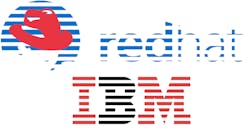The tidy sum of $33 billion is a lot of money, but that’s what IBM paid to close a deal with Red Hat. That’s about a 60% premium that a Red Hat stockholder, like me, happens to like. The news was big in the Linux arena, of which the embedded market is just a part. Red Hat also targets service support at the enterprise server market, not the embedded space.
So why will the Red Hat acquisition affect us as much if not more?
One of the big advantages of Linux is that it’s open source and is the common underpinnings to everything from Linux running on IoT devices and smartphones to the cloud running billions of virtual machines (VMs). One of the biggest supporters and contributors to the Linux kernel and Linux in general is Red Hat, and for a good reason. Red Hat Enterprise Linux (RHEL) is Red Hat’s bread and butter. It really sells support, but that’s the way commercial open source works these days.
One of the reasons IBM picked up Red Hat is its presence and support of the cloud. The cloud is also critical to IoT embedded applications; IBM has its own cloud services, including IBM’s Watson, its DeepQA artificial-intelligence project.
Direct Red Hat competitors like Ubuntu and Suse will be facing an even bigger challenge. It will be interesting to see if Red Hat makes any moves into the embedded space as Ubuntu has done with its Ubuntu Core and Snappy offering. Likewise, Arm’s new Mbed Linux, part of its Pelion offering, will link IoT nodes and gateways to Arm’s cloud.
The Red Hat acquisition isn’t the first big open-source acquisition, nor is IBM the only one investing in open source. Microsoft recently picked up GitHub, and Oracle acquired MySQL almost 10 years ago for $1 billion. Lest we forget, IBM’s Websphere turned into the open-source Eclipse integrated development environment (IDE) back around 2003.
In general, corporate adoption of open source has improved the openness and quality of open-source projects. Of course, your mileage may vary; some projects hit a brick wall while others flourished. Adapting a corporate culture to embrace open source that often had previously denigrated it is sometimes a way for bad things to happen. On the other hand, if the new acquisition is coming to the rescue or be the gold egg for future growth, then it tends to focus one’s attention.
It will be interesting to see how Red Hat’s free offerings, the CentOS server and Fedora platform, are handled. Red Hat has been doing very well both financially and with respect to the open-source community. Hopefully that will continue under IBM’s auspices.
About the Author
William G. Wong
Senior Content Director - Electronic Design and Microwaves & RF
I am Editor of Electronic Design focusing on embedded, software, and systems. As Senior Content Director, I also manage Microwaves & RF and I work with a great team of editors to provide engineers, programmers, developers and technical managers with interesting and useful articles and videos on a regular basis. Check out our free newsletters to see the latest content.
You can send press releases for new products for possible coverage on the website. I am also interested in receiving contributed articles for publishing on our website. Use our template and send to me along with a signed release form.
Check out my blog, AltEmbedded on Electronic Design, as well as his latest articles on this site that are listed below.
You can visit my social media via these links:
- AltEmbedded on Electronic Design
- Bill Wong on Facebook
- @AltEmbedded on Twitter
- Bill Wong on LinkedIn
I earned a Bachelor of Electrical Engineering at the Georgia Institute of Technology and a Masters in Computer Science from Rutgers University. I still do a bit of programming using everything from C and C++ to Rust and Ada/SPARK. I do a bit of PHP programming for Drupal websites. I have posted a few Drupal modules.
I still get a hand on software and electronic hardware. Some of this can be found on our Kit Close-Up video series. You can also see me on many of our TechXchange Talk videos. I am interested in a range of projects from robotics to artificial intelligence.


